Name Athabaskan Laid down 1 June 1969 Decommissioned 10 March 2017 Construction started 1 June 1969 Length 130 m Draft 4.7 m | Namesake Athabaskan Commissioned 30 September 1972 Refit 4 June 1994 (TRUMP) Launched 27 November 1970 Weight 5,100 tons | |
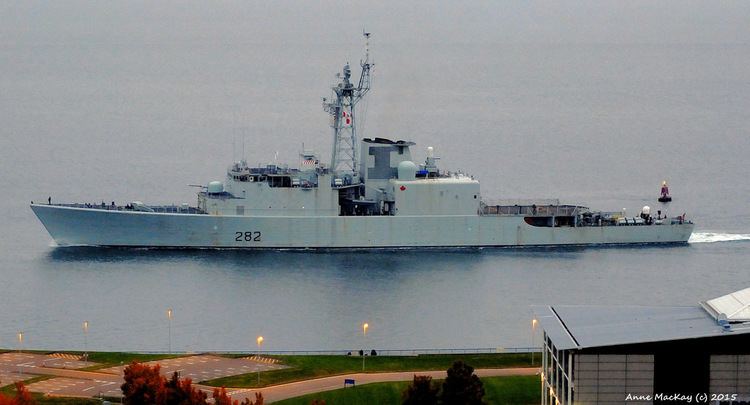 | ||
Hmcs athabaskan ddg 282 passing greenock
HMCS Athabaskan was an Iroquois-class destroyer that served in the Royal Canadian Navy from 1972 until 2017. Athabaskan was the third ship of her class which is sometimes referred to as the Tribal class or simply as the 280 class. She is the third vessel to use the designation HMCS Athabaskan.
Contents
- Hmcs athabaskan ddg 282 passing greenock
- Command team
- Service
- NATO missions in Atlantic Ocean
- IraqKuwait war in Persian Gulf
- Disaster relief in US
- Disaster relief in Haiti
- NATO exercises
- Decommissioning
- Engine
- Timeline
- References
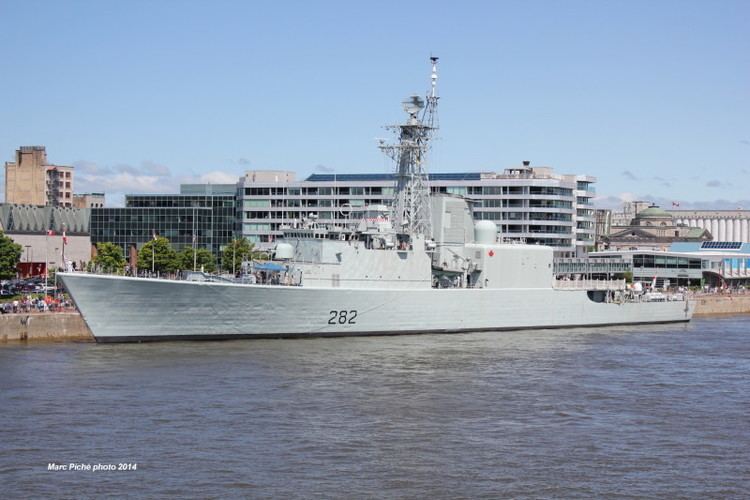
Athabaskan was laid down on 1 June 1969 at Davie Shipbuilding, Lauzon and was launched on 27 November 1970. She was officially commissioned on 30 September 1972 and carries the hull classification symbol 282.
Athabaskan completed a refit known as the Tribal Class Update and Modernization Project (TRUMP) on 4 June 1994. At this time her classification changed from Destroyer Helicopter (DDH) to Destroyer Guided Missile (DDG). She was assigned to Maritime Forces Atlantic (MARLANT) homeported at CFB Halifax.
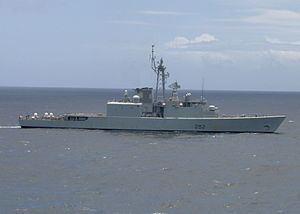
Command team
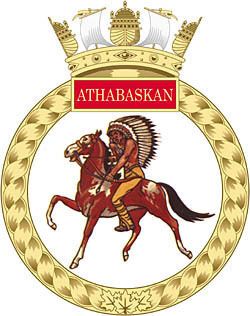
Service
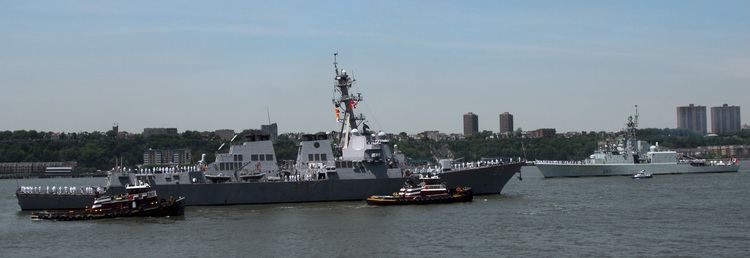
Athabaskan served on MARLANT missions protecting Canada's sovereignty in the Atlantic Ocean and enforcing Canadian laws in its territorial sea and Exclusive Economic Zone. She has also been deployed on missions throughout the Atlantic and to the Indian Ocean; specifically, the Persian Gulf and Arabian Sea after Iraq occupied Kuwait.
NATO missions in Atlantic Ocean
Athabaskan has also participated in several NATO missions, patrolling the Atlantic Ocean as part of Standing Naval Force Atlantic (STANAVFORLANT) and its successor Standing NATO Response Force Maritime Group 1 (SNMG1).
Iraq–Kuwait war in Persian Gulf
In August 1990, Athabaskan was hurriedly refitted with several advanced weapons and took part in Operation Friction and in Operation Desert Shield. The weapons included a close-in weapon system (CIWS). Athabaskan was appointed flagship of the Canadian Naval Task Group, which included the destroyer Terra Nova and supply ship Protecteur. The task group served in the central Persian Gulf, with other coalition naval forces, through the fall of 1990.
After Operation Desert Storm began in January 1991, the task group undertook escort duties for hospital ships and other vulnerable naval vessels of the coalition. The Ticonderoga-class cruiser USS Princeton detonated two Iraqi bottom-moored influence mines (MANTAs) at the north end of the Persian Gulf and was seriously damaged. Athabaskan was not assigned to the area, but the commanding officer of Princeton specifically requested her assistance. Unlike most ships of her size, Athabaskan could simultaneously operate two large CH-124 Sea King helicopters, which could search out mines for long periods. Athabaskan and her helicopters helped both ships avoid mines until the minesweeper USS Adroit escorted them out of the minefield. As a gesture of solidarity, Athabaskan winched over several cases of beer for the crew of Princeton, since United States Navy vessels were dry. Athabaskan returned to her task group and remained on station in the Persian Gulf until after the war ended. After the hostilities were complete she was relieved by her sister ship Huron. The professionalism of Athabaskan earned praise from Princeton's commanding officer, Captain Edward Hontz.[17]
Disaster relief in U.S.
On 2 September 2005, Athabaskan was one of several MARLANT vessels and a Canadian Coast Guard ship that were deployed to Mississippi and Louisiana to assist disaster relief efforts after Hurricane Katrina. This was part of the larger Canadian response to Hurricane Katrina.
Disaster relief in Haiti
On 14 January 2010, as part of Operation Hestia, following rapid outfitting Athabaskan and Halifax were deployed to Haiti to assist with disaster relief efforts after a 7.0 magnitude earthquake. This was as part of the larger multi-pronged Canadian response of DART (Disaster Assistance Response Team). The crew of the Athabaskan primarily concentrated relief efforts in the city of Léogâne where the crew assisted in triage efforts with the Canadian Medical Assistance Team, cleared rubble within Notre Dame Asylum, built three orphanages and lent aid to five others. Léogâne is a city of 135,000 that was slow to receive relief efforts and was almost completely destroyed by the earthquake. There were an estimated 20,000–30,000 casualties in the city.
NATO exercises
After experiencing a series of engine failures and maintenance issues, the ship underwent repairs. The ship was repaired and set sail on 8 September 2015, NATO naval exercises Joint Warrior and Trident Venture with Windsor, Halifax, Montréal, Goose Bay and Summerside. However, the starboard cruise engine failed while crossing the Atlantic. The ship sailed to the United Kingdom where she was joined by a mobile repair team which replaced the engine.
In September 2016 Athabaskan was among the Canadian warships deployed to the NATO naval training exercise "Cutlass Fury" off the east coast of North America.
Decommissioning
In September 2016, the RCN announced that Athabaskan would be paid off in the spring of 2017, leaving the navy without a platform capable of long-range air defence, at least until the introduction of the planned Canadian Surface Combatant. The vessel was decommissioned on 8 March 2017.
Engine
In 2009, a man in Nova Scotia discovered one of Athabaskan's pre-1994 refit engines in a shipping container he had been using as a bridge on his property. The man had bought the container for $400 believing it was empty. The engine was originally valued at $2 million.
